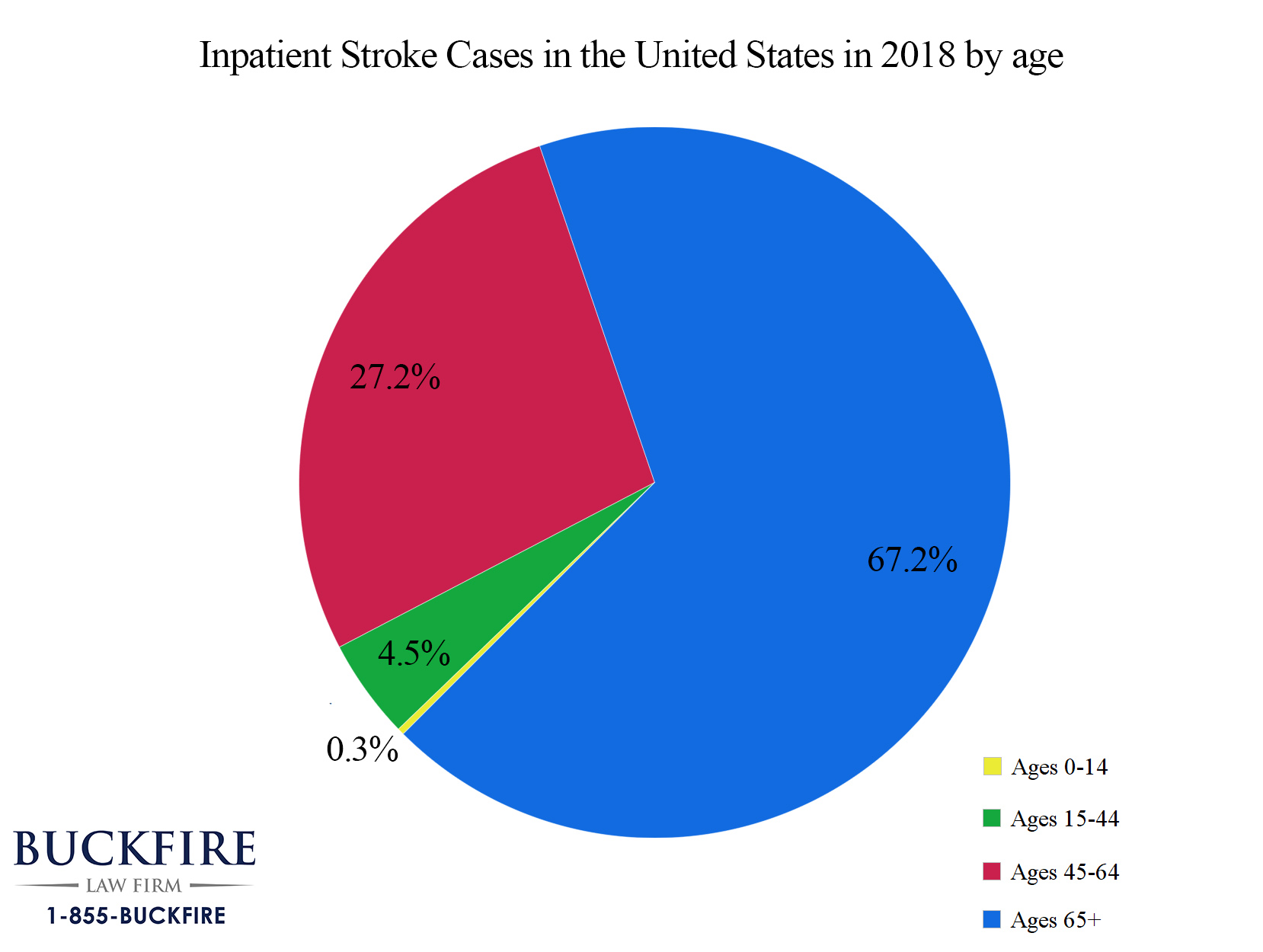A stroke misdiagnosis lawyer helps patients who were the victims of medical malpractice. The Buckfire Law Firm handles medical negligence cases involving cerebral vascular accidents. Even though stroke symptoms may resemble other medical issues, it is still a medical professional’s duty to accurately assess a patient’s condition and provide prompt and proper treatment.
When a misdiagnosis of a stroke occurs, this will delay treatment, which raises the risk of complications and death. When stroke victims do not get the prompt treatment they need, they suffer permanently reduced mental capacity, problems with speech and movement, or even death.
If you or a loved one was misdiagnosed, you have legal options. You will benefit from contacting a Michigan stroke misdiagnosis lawyer for help. A tenacious attorney will represent your interests during a claim and work tirelessly to secure the compensation you deserve.
- Reduce Your Chance of Suffering a Stroke
- Types of Strokes
- Urgent Diagnosis & Treatment to Prevent Major Damage
- How do I File a Stroke Medical Malpractice Lawsuit?
- Michigan Stroke Misdiagnosis Malpractice Settlements
What is a Stroke?
A stroke, or cerebral vascular accident (CVA), is a medical event that occurs when there is a quick interruption of the blood flow to the brain, often without warning. The longer the brain cells are deprived of blood and oxygen, the more likely they are to die and cause the patient severe problems. The effects of a stroke are often permanent and can lead to death.
Statistics from the Center for Disease Control show that 7.8 million Americans have suffered a stroke. This is 3.1% of the U.S. population. In 2017, strokes were the fifth leading cause of death in the United States. There were 146,383 deaths caused by cerebral vascular accidents. Often, receiving a fast diagnosis and treatment is key to decreasing the chance of side effects. It also gives a patient the highest likelihood of surviving a stroke.
Stroke Statistics in the United States
This graph shows the amount of hospital inpatient stroke cases in the United States by age in the year 2018. Patients ages 65 years and older accounted for 67 percent of the cases.
The Effects of Healthy Living
Many healthy people suffer from strokes, even younger adults. However, there are steps you can take to prevent and reduce your chance of suffering a stroke.
Doctors urge patients to follow several suggestions to prevent a stroke. They are:
- Healthy Diet: Eating healthy meals and foods low in saturated fats, trans fat, and cholesterol helps keep your blood pressure low. High cholesterol and high blood pressure are risk factors for a stroke. Eating a proper diet can decrease your chances of having one.
- Watch Your Weight: Overweight and obese people are more at risk for a stroke. In addition to eating healthy foods, pay attention to the quality and quantity consumed.
- Exercise: Physical activity plays an important factor in your weight, blood pressure, and cholesterol. Doctors suggest walking and other moderate aerobic physical activity on a daily basis.
- Smoking: Cigarettes and smoking other tobacco products greatly increase your chances of having a stroke.
- Drinking: Drinking too much alcohol can raise your blood pressure. Drink in moderation to minimize your risk of a stroke.
Types of Strokes
There are three different types of stroke. Each type can cause permanent impairment and disability. Early detection and treatment can minimize the harm.
Transient Ischemic Attack
This type of stroke is also referred to as a TIA. It is often seen as a mini-stroke or a warning for a more serious stroke. A TIA causes a temporary blockage of blood to the brain. A transient ischemic attack can go away without treatment. However, a patient with a TIA should see medical treatment for therapies to prevent a more serious stroke.
Ischemic Stroke
An ischemic stroke occurs when a blood clot stops the blood from flowing to the brain. There are a number of reasons for the blockage. The main cause for blockage is the buildup of fatty deposits in the blood vessel. This is known as atherosclerosis. Almost 90% of strokes are ischemic strokes. Unlike a transient ischemic stroke, the blood clot does not go away without medical treatment.
Hemorrhagic Stroke
A hemorrhagic stroke is caused when a blood vessel in the brain ruptures or breaks. The result is the spilling of blood in the tissues surrounding the brain. A brain aneurysm is a type of hemorrhagic stroke. Another type is arteriovenous malformation, a condition caused by abnormally formed blood vessels.
Urgent Diagnosis & Treatment to Prevent Major Damage
Doctors are trained to suspect a possible stroke when a patient presents with certain symptoms. The most common signs and symptoms are:
- Severe headache
- Sudden confusion
- Vision changes
- Problems with walking or balance
- Difficulty with speaking
When a doctor sees these symptoms, it is the standard of care to order diagnostic tests such as a CT scan or an MRI. Time is of the essence so testing needs to be urgently performed.
A failure to diagnose, or a misdiagnosis, results in a delay of necessary treatment. This can result in catastrophic consequences to the patient. When a doctor fails to order required tests or initiate treatment, the patient will benefit from consulting with a stroke misdiagnosis lawyer in Michigan.
Strokes are often Misdiagnosed as Migraines
Many patients who are admitted to hospitals, emergency rooms, and urgent care clinics have a history of migraine headaches. However, it is essential for doctors who see these patients consider the diagnosis of a stroke. It is wrong to just assume it is simply another migraine.
Unfortunately, many patients with migraine histories are improperly discharged from emergency departments. They are not provided a proper medical workup for a stroke. As a result, effective treatment to reduce or eliminate the blood clot before permanent brain damage is not done.
Can I Sue for a Misdiagnosis of a Stroke?
When a patient presents to an urgent care clinic or hospital emergency department with signs of a stroke, it is essential that proper care be initiated immediately. This includes having a CT scan or other radiology studies and being promptly evaluated by a neurologist.
The sooner treatment is started, the better likelihood of minimizing damage to the brain. Many stroke treatments must be administered in a short window of time. This includes tPA, a clot-busting medication that must be given within 3-4 hours of a stroke to be effective.
Other medications can also be given to break up clots before they cause permanent damage to the brain. Other treatments are more invasive and are generally performed by an interventional cardiologist or radiologist. These include coiling and clamping procedures.
For severe cases, a neurosurgeon may perform emergency craniotomy surgery to clip relieve the pressure on the brain. When there is a misdiagnosis of a stroke, these opportunities are lost to the patient. Any delay resulting in harm gives rise to liability against the clinic, hospital, and physician.
How do I File a Stroke Medical Malpractice Lawsuit?
A stroke misdiagnosis lawyer at Buckfire Law Firm will get all of your medical records and radiology studies. We will review them and speak with nationally respected medical experts about your case.
Michigan law requires that a physician certify that you have a meritorious case before you can file a lawsuit. To win a case, you must prove there was an unacceptable delay in diagnosis and treatment. You must also prove that earlier treatment would have resulted in a better outcome.
If the medical experts support your case, we will file a stroke medical malpractice lawsuit for you. We regularly win top settlements in medical malpractice lawsuits.
Stroke Misdiagnosis Malpractice Case Study
A medical malpractice lawsuit alleged negligence against a hospital for failing to properly treat an impending stroke.
A 56-year-old mother went to the hospital due to a severe headache, dizziness, neck pain, and numbness. She had a CT scan which was reported as normal and she was discharged home.
The woman later suffered a serious stroke causing quadriplegia. She sued the hospital and doctors for failing to do other radiology studies, like a CTA or MRA. The suit claimed those studies would have led to a proper diagnosis and appropriate treatment.
The hospital fought the lawsuit and argued it acted appropriately. Medical experts for each side disputed liability. The case later settled for $2.1 million.
What is the Compensation in a Stroke Misdiagnosis Lawsuit?
The compensation sought in a civil liability case are damages. There are two different types of damages of claimed damages: economic and non-economic.
Economic Damages
These damages—also known as compensatory damages—represent the ways the plaintiff suffered financially from their maltreatment. Compensatory damages include lost wages from the inability to go to work, medical expenses, and legal expenses.
These damages are also calculated into the future for a patient with permanent disability from employment or the need for lifetime medical care. State law does not place any restrictions on how much money a stroke malpractice plaintiff could receive in compensatory damages.
Non-Economic Compensation
Non-economic damages are those that are intangible, such as pain and suffering, loss of enjoyment of life, loss of consortium, and mental anguish. In cases involving stroke malpractice, the long-term effects on a person’s life are substantial.
The patient may need assistance with activities of daily living and may not even be able to drive due to the damage to the brain. The law provides compensation for this type of harm, including for the past, present, and future.
Most stroke malpractice cases provide compensation that combines the economic and non-economic damages for a large settlement. In cases involving a patient’s death, the surviving family members can file a wrongful death lawsuit. These lawsuits provide settlement payouts for the pain and suffering of the decedent prior to death.
Wrongful death settlements also compensate the family for the loss of companionship of the loved one, as well as for loss of financial support and other economic losses.
Michigan Stroke Misdiagnosis Malpractice Settlements
- $1,825,000 settlement for a man who suffered a stroke due to trauma in an auto accident. The condition was not diagnosed at the emergency room and he suffered permanent brain damage.
- $1,600,000 settlement against an emergency room physician and hospital for a patient who suffered a severe stroke as a result of an undiagnosed brain aneurysm.
- $1,000,000 settlement in a lawsuit against a radiologist who failed to diagnose findings of the new stroke on the CT scan and also failed to communicate these findings to the doctors in a prompt manner so they could properly treat the patient to prevent her death.
- $845,000 wrongful death settlement in a medical malpractice lawsuit filed by the family of a woman who died from a massive cerebral sinus thrombosis. She had presented to her neurologist ten days before the stroke with symptoms and he was negligent in providing proper treatment.
Call a Michigan Stroke Misdiagnosis Lawyer for Help
If you or a loved one was the victim of medical negligence related to a stroke, contact an experienced stroke misdiagnosis for help. We will start working on your case immediately. There are strict time deadlines for filing medical malpractice lawsuits in Michigan. If you miss a deadline, your case will be lost forever.
We do not charge any legal fees unless you get a settlement. And, we pay all of the case costs and expenses. We are ready and eager to start your case. Contact us now!
(Main)
- 29000 Inkster Road
Suite 150
Southfield, MI 48034
- Phone: (248) 595-7544
- 19 Clifford St.
Suite 805 Merchants Row
Detroit, MI 48226
- Phone: (313) 992-8281
(Woodward Address)
- 1001 Woodward Ave.
Suite 505
Detroit, MI 48226
- Phone: (313) 777-8482
- 343 S. Main Street
#206
Ann Arbor, MI 48104
- Phone: (734) 888-3003
- 51424 Van Dyke Ave
#3
Shelby Township, MI 48316
- Phone: (586) 250-2626
- 432 N. Saginaw Street
Suite 413
Flint, MI 48502
- Phone: (810) 818-8182







